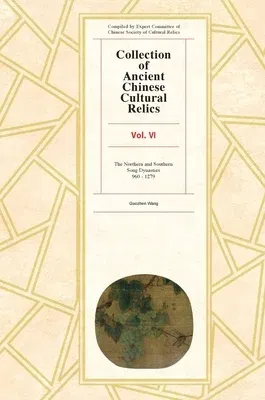This book, a collection of ancient Chinese cultural relics from the
Northern and Southern Dynasties from 960 to 1279. It covers jade and
bronze ware, gold and silver ware and porcelain ware, pottery,
porcelain, painting, calligraphy, and handicrafts. There are 363 relics
in the book. In 960, Zhao Kuangtin, commander of the imperial guard
troops of the later Zhou Dynasty staged a mutiny at Chenqiao and
proclaimed himself emperor. He named his new dynasty the Song Dynasty
and chose Dongling Kaifeng for the capital. This dynasty now called the
Northern Song in history, gradually eliminated rival regimes and ended
the separation of the Five Dynasties and Ten Kingdoms, co-existing with
the Liao Regime established by the Qidan ethic group and Western Xia
Regime established by the Dangxian ethic group. In 1127 Emperors Huizong
and Quinzong were taken captive by the Jin Dynasty established by the
Jurchen people, thus ending the Northern Song Dynasty. In the same year,
Zhao Gou, then King King, established the imperial court of Song and
moved the capital to Linhan (present day Hangzhou City in Zhejiang).
This is what history calls the Southern Song Dynasty, and formed a
glance at the Jin and Western Xia. In this period, thanks to easy
politics and a relatively emancipated ideology, great achievements were
obtained in various scientific technologies, theoretical trends,
academic schools, religious thought and literary creation and the arts
also showed an unprecedented prosperous science. Jade ware penetrated
various aspects of social life, and he shapes, decorations and patterns
all showed a distinctive secularisation. The invasion of northern nomads
introduced a new cultural atmosphere to the Central Plains. The
porcelain kilns could be found everywhere and finally developed into
eight major systems: Ding, Yaozhou, Cizhou, Jun, Yuezhou, Longquan,
Jingdezhen blueish white porcelain and Jian kilns. As well, there were
four major royal kilns: Ru Kiln and Jun Kiln of the Northern Song
Dynasty and Xiunesisi Kiln and Jiaotanxia Kiln of the Southern Dynasty.
The arts of calligraphy and painting were typical representatives of the
flourishing culture in the Song Dynasty. During this period an imperial
art academy was founded, enlisting folk artists and a large number of
professional painters were trained. Calligraphers of the Northern and
Southern Song Dynasties inherited previous styles but also emphasised
the representation of the individual subjective will. Other handicrafts
developed: gold and silver ware tended to be light, handy and graceful.
In the Song Dynasty, people has less costly funerals so less jade has
been unearthed. Those that have are in: Sichuan, Zhejiang and Jiangxis.
The emphasis is on practical utensils, drinking vessels, dress
adornments and accessories. At the same time, there was progress in the
technologies of jade carving: layered piercing and large-scale jade
ware. This book, the sixth in a ten-volume collection, brings to the
English-speaking world a series of books from China which has been
complied by an Expert Committee of the Chinese Society of Cultural
Relics. There are 363 descriptions.

